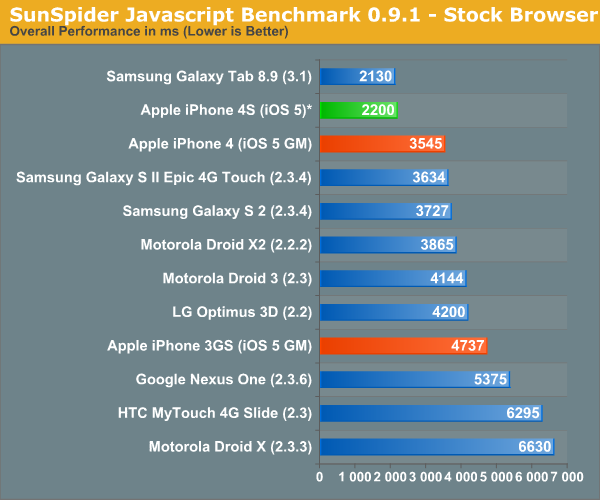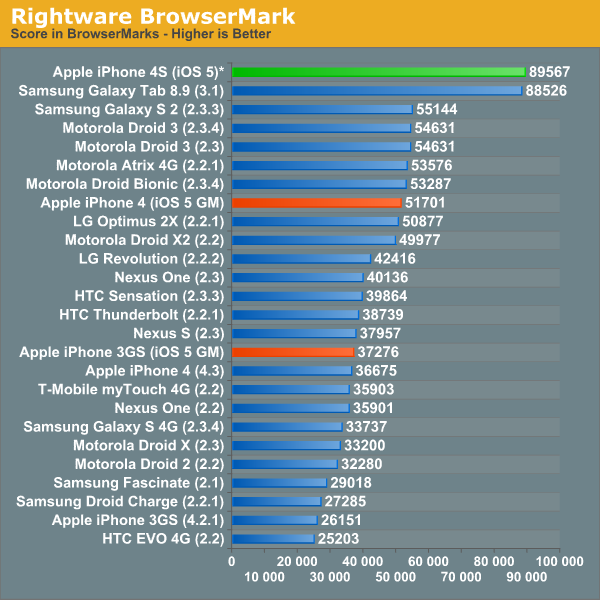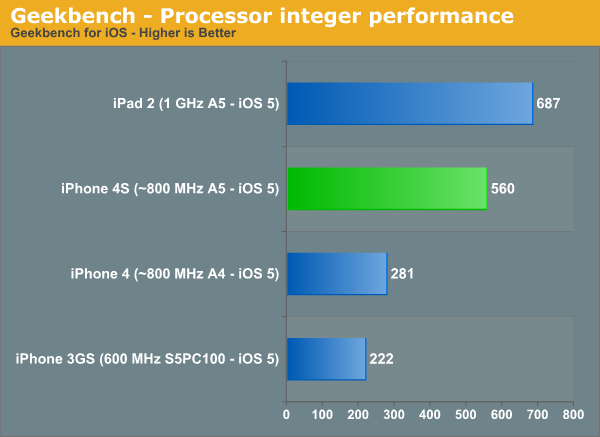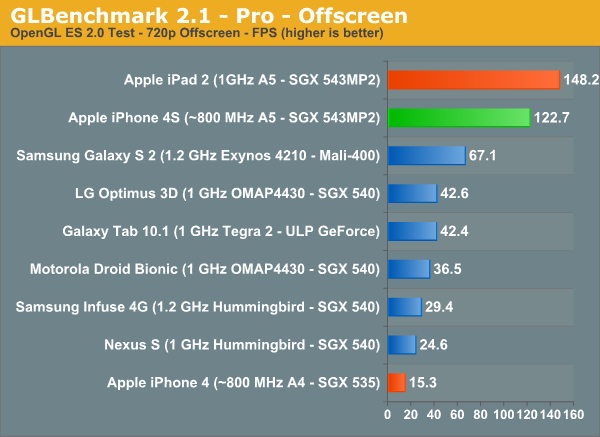iPhone 4S Preliminary Benchmarks: ~800MHz A5, Slightly Slower GPU than iPad 2, Still Very Fast
by Anand Lal Shimpi & Brian Klug on October 11, 2011 3:22 AM EST- Posted in
- Smartphones
- Apple
- Mobile
- iPhone 4S
- SoCs
Apple's ability to control the entire information chain, down to the point of limiting leaks, appears to be gradually slipping as it grows as a company. Case in point are the numerous hardware and performance leaks surrounding the newly launched iPhone 4S. Little did we know that several weeks ago we were staring at photos of the 4S' PCB, and more recently we've seen the first performance results from Apple's first A5 based smartphone thanks to a few eager users around the web. We've compiled these results here from various sources (all linked below) and compared them to our existing database of tests.
The results are pretty much as expected. Javascript performance finally catches up to Tegra 2 based Honeycomb devices, while general CPU performance is significantly higher than the iPhone 4. I suspect Ice Cream Sandwich will bridge the Android smartphone gap (the Honeycomb equipped Gtab 8.9 is here to give you an idea of where a more modern Android browser ends up).
Keep in mind that all of these tests measure performance of the software stack in addition to the hardware. In particular the web browser tests depend largely on browser optimizations, which is why we see differences between similar hardware running different browser versions. Also note that all results were run at stock, with the stock browser. Finally, although these browser tests were captured on video we'll still be running our official tests once our 4Ses arrive and will update accordingly.


Using some of the integer and fp tests of published Geekbench scores we can already conclude that Apple is shipping a lower clocked A5 in the iPhone 4S than it does in the iPad 2. This naturally makes sense as the iPhone 4S has a much smaller 5.25 Whr battery. Based on the Geekbench results it looks like the iPad 2 is clocked around 25% higher than the iPhone 4S, pegging the latter's clock speed at 800MHz.


A lower clock not only means higher yields from the factory, but likely a lower operating voltage as well. Dropping a CPU's core voltage, yields a greater-than-linear decrease in power consumption, making the marginal loss in clock speed a good choice. At a lower operating frequency than its Android competitors, Apple does have to exploit its strengths in software to avoid any tangible performance penalties. Apple has traditionally done this very well in the past, so I don't expect the loss of frequency to be a huge deal to the few who do cross-shop iOS and Android.
Unsurprisingly, memory bandwidth doesn't appear to have gone up either compared to the iPad 2's A5 (taking into account scaling due to CPU clock increases). The Samsung part number on the iPad 2's A5 indicates two LPDDR2-800 die on package, it's safe to assume that whatever Apple clocked the memory interface at in the iPad 2 remains unchanged in the iPhone 4S.
The GPU results tell a similar story courtesy of some early GLBenchmark 2.1 results. The 960 x 640 results are useless as they are bound by vsync at ~60 fps. Luckly GLBenchmark 2.1 added an off-screen render mode at 1280 x 720 where we can really see the differences between the iPad 2 and iPhone 4S A5 implementations:


Here the iPad 2 holds a ~21% performance advantage, which once again I assume to be all related to clock speed. Also note the huge advantage over the existing iPhone 4. The GPU power in the 4S should be more than enough to run any well written, current generation title at well north of 30 fps on its display.
We'll be reviewing the iPhone 4S in the coming weeks, stay tuned!
Source: GLBenchmark Database, Geekbench Database, Macrumors










216 Comments
View All Comments
cditty - Tuesday, October 11, 2011 - link
I definitely agree. If you are going to do Android, it should always be a 'Google Experience' device. It gets updated like a real phone should.steven75 - Tuesday, October 11, 2011 - link
Yep, and sadly there's no modern Nexus phone for those of us that are strongly against the giant display wars.I won't consider an Android phone that I have to wait 8 months to update after being on iOS for years now where we get updates literally the day they came out.
Piano Man - Tuesday, October 11, 2011 - link
Why or why can't this phone have LTE. Then there would be no competition, and I could buy this phone in peace :)relentlessfocus - Tuesday, October 11, 2011 - link
Battery life vs number of places that actually have LTEinplainview - Tuesday, October 11, 2011 - link
Didn't you read the reason's why there is no LTE in the 4S? Dear God, it can't be that hard...Please do every one a favor and don't buy a 4S. This way you can buy something else and keep the whining to yourself.
JasonInofuentes - Tuesday, October 11, 2011 - link
Relevant. http://www.anandtech.com/show/4925/why-no-lte-ipho...TL;DR: Add LTE and you'd have a power hungry thicker device. Leave it out and next year you'll have an even thinner, less power hungry device with LTE.
MonkeyPaw - Tuesday, October 11, 2011 - link
AND you can sell yet another new phone. ;)name99 - Tuesday, October 11, 2011 - link
Dear god this is a stupid comment.What exactly is your argument here? That Apple is deliberately updating their phones slowly so as to get people to buy a new phone every year?
So what's your view of what Android phone vendors are doing? Their updating their phones every three months somehow doesn't force people to buy a new phone every three months, but Apple's once a year update does?
So according to you BOTH of these hold
- Apple released a new phone (which, in your opinion sux) AND
- this new phone is of not much appeal to people already on contract with an iPhone 4 AND
- presumably Apple's new phone in 2012 WILL be appealing to iPhone4 customers? AND
- this is bad?
So Apple releasing phone updates in a way that matches well the two year phone updating schedule of people on contract is "an evil plan to sell phones
to people who don't want them"? I'm sorry but the logic here totally eludes me.
(Compare with the following statements
- iPhone 4S sux because the appearance didn't change
- Android phones change their appearance every three months
THEREFORE
- Apple sheeple all buy phones based on appearance and fashion
Huh?)
deV14nt - Wednesday, October 12, 2011 - link
People expected Apple to change the appearance as in: "make the screen bigger".This is shorthand for:
- a better web browsing experience
- a better movie watching experience
- a less crowded keyboard
- more touchscreen real estate, making things less crowded
and many other benefits to increasing the screen size from lowest-in-class 3.5 inches to something more reasonable like 4.0" or more.
Apple has created just about the most powerful mobile gaming device. But they kept a small screen on it. Unfortunate for those who want to use it for that. Personally not my thing. So add this to the list of benefits from bigger screen size:
- better gaming controls and usability
The "appearance and fashion" you may be referring to is the sleek but unnecessary materials. For example, the back of the phone. Personally, first thing I do when I get an expensive phone is put it in a case. I like to watch the cheap plastic battery cover film that Samsung uses as it becomes completely enclosed by my snug rubberized white Case-Mate case and think of all the money saved that actually goes towards things that matter. As a result, the phone is lighter and gets better signal as a bonus.
But I think you're mixing a lot of other criticisms about frivolous reasons to get a particular phone into that "appearance" category. There are many.
vinzclortho - Wednesday, October 12, 2011 - link
Agreed about the screen size. A bigger screen would be nice so long as it doesn't increase the dimensions of the iPhone to the pocket-bursting enormity of some of the recent androids.I suspect that Apple kept the current retina display for logistical reasons. They're a single company competing with the growth of an entire industry, so they need to crank out a _lot_ of devices to maintain or grow market share. A tiny high res lcd like theirs is damn hard to mass produce. Now that their existing factories are dialed in pretty well, retooling for a bigger screen would introduce risk of part shortages.